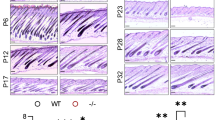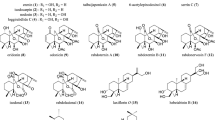Abstract
Primary cultures of human hair follicle keratinocytes were established by using a basement membrane-like growth substrate, the bovine eye lens capsule. A method was adapted for the isolation of 3H-benzo(a)pyrene (BP)-modified DNA from the cellular outgrowth of only one hair follicle (approximately 2×105 cells). In a routine procedure hair follicle keratinocytes were incubated with 0.5 μM 3H-BP for 24 h. The purified DNA was subjected to enzymic hydrolysis and the adducts were analyzed by Sephadex LH-20 column chromatography followed by HPLC. Only one major adduct, which represented 60–80% of the total radioactivity which can be confined to modified nucleosides in the LH-20 chromatograph, could be identified. This adduct co-chromatographed with the marker adducts resulting from the trans-addition of the N-2-amino group of guanine to the 10-position of (±)-7β,8α-dihydroxy-9α,10α-epoxy-7,8,9,10-etrahydrobenzo(a)pyrene.
Co-incubation with 7,8-benzoflavone (0.3 μM), an inhibitor of cytochrome P-448, and with 1,1,1-trichloropropene-2,3-oxide (0.2 μM), an inhibitor of epoxide hydrolase, resulted in a marked inhibitory effect (15% of the control binding) and a large increase (300% of the control value) in BP-DNA binding respectively. Induction of aryl hydrocarbon hydroxylase activity in the cultures with 5,6-benzoflavone (10 μM) or benz(a)anthracene (10 μM) caused a decrease (75 and 46% of the control value respectively) in BP-DNA binding. The ratio between “total” binding (as calculated from the specific activity of the isolated DNA) and “true” binding (represented by the BP-nucleoside adducts eluted from the HPLC column) appeared to be rather constant in cultures from four different individuals. Therefore, total binding may serve as a good representative of true binding. Using cultures from hair follicles of eight different persons, interindividual variation was 4-fold, with a mean binding of 2.4×109 molecules/μg DNA. Since it has been demonstrated that the formation of dihydrodiols of BP — among them the proximate carcinogen 7,8-dihydrodiol-BP — in freshly isolated hair follicles is largely genetically determined (Hukkelhoven et al. 1982), the interindividual differences in binding may possibly reflect individual variation in susceptibility to BP-induced neoplasia.
Similar content being viewed by others
References
Alexandrov K, Thomposon MH (1977) Influence of inducers and inhibitors of mixed function oxidases on benzo(a)pyrene binding to the DNA of rat liver nuclei. Cancer Res 37: 1443–1449
Andersson MW, Bend JR (1983) In vivo metabolism of benzo(a)pyrene: formation and disappearance of BP-metabolite-DNA adducts in extrahepatic tissues versus liver. In: Rydström J, Montelius J Bengtsson M (eds) Extrahepatic drug metabolism and chemical carcinogenesis. Elsevier Science Publishers; Amsterdam, pp 459–467
Autrup H, Harris CC, Trump BF, Jeffrey AM (1978a) Metabolism of benzo(a)pyrene and identification of the major benzo(a)pyrene-DNA adducts in cultured human colon. Cancer Res 38: 3689–3696
Autrup H, Barrett LA, Jackson FE, Jesudason ML, Stoner GD, Phelps P, Trump BF, Harris CC (1978b) Explant culture of human colon. Gastroenterology 74: 1248–1257
Baird WM, Brookes P (1973) Isolation of the hydrocarbon-deoxyribonucleoside products from the DNA of mouse embryo cells treated in culture with 7-methyl-benz(a)anthracene-3H. Cancer Res 33: 2378–2385
Bigger CAH, Tomaszewski JE, Dipple A, Lake RS (1980) Limitations of metabolic activation systems used with in vitro tests for carcinogens. Science 209: 503–505
Boobis AR, Nebert DW, Pelkonen O (1979) The effects of microsomal enzyme inducers in vivo and inhibitors in vitro on the covalent binding of benzo(a)pyrene metabolites to DNA catalyzed by liver microsomes from genetically responsive and nonresponsive mice. Biochem Pharmacol 28: 111–121
Brookes P (1977) Mutagenicity of polycyclic aromatic hydrocarbons. Mutat Res 39: 257–284
Buening MK, Wislocki PG, Levin W, Yagi H, Thakker DR, Akagi H, Koreeda M, Jerina DM, Conney AH (1978) Tumorigenicity of the optical enantiomers of the diastereomeric benzo(a)pyrene 7,8-diol epoxides in newborn mice: exceptional activity of (+)7β,8α-dihydroxy-9α,10α-epoxy-7,8,9,10-tetrahydrobenzo(a)pyrene. Proc Natl Acad Sci USA 75: 5358–5361
Daniel FB, Schut HAJ, Sandwisch DW, Schenck KM, Hoffmann CO (1983) Interspecies comparisons of benzo(a)pyrene metabolism and DNA-adduct formation in cultured human and animal bladder and tracheobronchial tissues. Cancer Res 43: 4723–4729
Decad GM, Hsieh DPH, Byard JL (1977) Maintenance of cytochrome P-450 and metabolism of aflatoxin B1 in primary hepatocyte cultures. Biochem Biophys Res Commun 78: 279–287
Dipple A (1976) Polynuclear aromatic carcinogens. In: Searle CE (ed) American Chemical Society Monograph, No. 173, American Chemical Society, Washington DC, pp 245–314
Feldman G, Remsen J, Shinohara K, Cerutti P (1978) Excisability and persistence of benzo(a)pyrene DNA adducts in epitheloid human lung cells. Nature 274: 796–798
Gelboin HV (1977) Cancer susceptibility and carcinogen metabolism. New Engl J Med 297: 384–387
Hammond EC, Selikoff IJ, Lawther PL, Seidmam H (1976) Inhalation of benzo(a)pyrene and cancer in man. Ann NY Acad Sci 271: 116–124
Harris C, Autrup H, Connor R, Barrett L, McDowell E, Trump B (1976) Interindividual variation in binding of benzo(a)pyrene to DNA in cultured human bronchi. Science 194: 1067–1069
Harris CC, Autrup H, Trump BF, Hillman E, Schafer P, Jeffrey A (1979) Metabolism of benzo(a)pyrene, N-nitrosodimethylamine and N-nitrosopyrrolidine and identification of the major carcinogen-DNA adducts formed in cultured human esophagus. Cancer Res 39: 4401–4406
Harris CC (1983) Carcinogenesis studies using cultured human tissues and cells (Meeting report) Cancer Res 43: 1880–1883
Heimann R, Rice RH (1983) Polycyclic aromatic hydrocarbon toxicity and induction of metabolism in cultivated esophageal and epidermal keratinocytes. Cancer Res 43: 4856–4862
Hukkelhoven MWAC, Vermorken AJM, Bloemendal H (1980) A novel method for culturing epithelial cells on a biological substrate. Prep Biochem 10: 473–481
Hukkelhoven MWAC, Vromans E, Markslag AMG, Vermorken AJM (1981) A simple fluorimetric microassay for DNA in hair follicles or fractions of hair follicles. Anticancer Res 1: 341–344
Hukkelhoven MWAC, Vermorken AJM, Vromans E, Bloemendal (1982) Human hair follicles, a convenient tissue for genetic studies on carcinogen metabolism. Clin Genet 21: 53–58
Hukkelhoven MWAC, Dijkstra AC, Vermorken AJM (1983a) Rapid high-performance liquid chromatographic method for detection of interindividual differences in carcinogen metabolism. J Chromatogr Biomed Appl 276: 189–196
Hukkelhoven MWAC, Dijkstra AC, Vermorken AJM (1983b) Human hair follicles and cultured hair follicle keratinocytes as indicators for individual differences in carcinogen metabolism. Arch Toxicol 53: 265–274
I.A.R.C. (1973) Monographs on the evaluation of carcinogenic risk of chemicals to man, Vol. 3; International Agency for Research on Cancer, Lyon, pp 91–137
Jeffrey AM, Weinstein IB, Jennette KW, Grzeskowiak K, Nakanishi K, Harvey RG, Autrup J, Harris CC (1977) Structures of benzo(a)pyrene-nucleic acid adducts formed in human and bovine bronchial explants. Nature 269: 348–350
Jennette KW, Jeffrey AM, Blobstein SH, Beland FA, Harvey RG, Weinstein IB (1977) Nucleoside adducts from the in vitro reaction of benz(a)pyrene-7,8-dihydrodiol 9,10-oxide or benzo(a)pyrene 4,5-oxide with nucleic acids. Biochemistry 16: 932–938
Kahl GF, Klaus E, Legraverend C, Nebert DW, Pelkonen O (1979) Formation of benzo(a)pyrene metabolite-nucleoside adducts in perfused rat and mouse liver and in mouse lung slices. Biochem Pharmacol 28: 1051–1056
King HWS, Osborne MR, Beland FA, Harvey RG, Brookes P (1976) (±)-7α,8β-dihydroxy-9β,10β-epoxy-7,8,9,10-tetrahydrobenzo(a)-pyrene is an intermediate in the metabolism and binding to DNA of benzo(a)pyrene. Proc Natl Acad Sci USA 73: 2679–2681
Koreeda MN, Moore PD, Wislocki PG, Levin W, Conney AH, Yagi H, Jerina DM (1978) Binding of benzo(a)pyrene 7,8-diol-9,10-epoxides to DNA, RNA and protein of mouse skin occurs with high stereoselectivity. Science 199: 778–781
Levin W, Wood A, Chang R, Ryan D, Thomas R, Yagi H, Thakker D, Vyas K, Boyd C, Chu S-Y, Conney A, Jerina D (1982) Oxidative metabolism of polycyclic hydrocarbons to ultimate carcinogens. Drug Metab Rev 13: 555–560
MacNicoll AD, Easty GC, Neville AM, Grover PL, Sims P (1980) Metabolism and activation of carcinogenic polycyclic hydrocarbons by human mammary cells. Biochem Biophys Res Commun 95: 1599–1606
Miller EC, Miller JA (1981) Searches for ultimate chemical carcinogens and their reactions with cellular macromolecules. Cancer 47: 2327–2345
Newbold RF, Wigley CB, Thompson MH, Brookes P (1977) Cell-mediated mutagenesis in cultured Chinese hamster cells by carcinogenic hydrocarbons. Nature and extent of the associated hydrocarbon-DNA reaction. Mutat Res 43: 101–116
Parkinson EK, Newbold RF (1980) Benzo(a)pyrene metabolism and DNA adduct formation in serially cultivated strains of human epidermal keratinocytes. Int J Cancer 26: 289–299
Pelkonen O, Boobis AR, Yagi H, Jerina D, Nebert DW (1978) The tentative identification of benzo(a)pyrene metabolite-nucleoside complexes produced in vitro by mouse liver microsomes. Mol Pharmacol 14: 306–322
Philips DH, Grover PL, Sims P (1978) The covalent binding of polycyclic hydrocarbons to DNA in the skin of mice of different strains. Int J Cancer 22: 487–494
Philips DH, Grover PL, Sims P (1979) A quantitative determination of the covalent binding of a series of polycyclic hydrocarbons to DNA in mouse skin. Int J Cancer 23: 201–208
Slaga TJ, Viaje A, Bracken WM, Berry DL, Fischer SM, Miller DR, Leclerc SM (1977) Skin-tumor-initiating ability of benzo(a)pyrene-7,8-diol-9,10-epoxide (anti) when applied topically in tetrahydrofuran. Cancer Lett 3: 23–30
Stampfer MR, Bartholomew JC, Smith HS, Bartley JC (1981) Metabolism of benzo(a)pyrene by human mammary epithelial cells: toxicity and DNA adduct formation. Proc Natl Acad Sci USA 78: 6251–6255
Straub KM, Meehan T, Burlingarre AL, Calvin M (1977) Identification of the major adducts formed by reaction of benzo(a)pyrene diol epoxide with DNA in vitro. Proc Natl Acad Sci USA 74: 5285–5289
Theall G, Eisinger M, Grunberger D (1981) Metabolism of benzo(a)pyrene and DNA adduct formation in cultured human epidermal keratinocytes. Carcinogenesis 2: 581–587
Thompson MH, King HWS, Osborne MR, Brookes P (1976) Rat liver microsome-mediated binding of benzo(a)pyrene metabolites to DNA, Int J Cancer 17: 270–274
Vähäkangas K, Nebert DW, Pelkonen O (1979) The DNA binding of benzo(a)pyrene metabolites catalyzed by rat lung microsomes in vitro and in isolated perfused rat lung. Chem Biol Interact 24: 167–176
Vermorken AJM, Goos CMAA, Roelofs HMJ, Henderson PTh, Bloemendal H (1979) Metabolism of benzo(a)pyrene in isolated human scalp hair follicles. Toxicology 14: 109–116
Vermorken AJM, Bloemendal H (1979) Is the hair root a useful biopsy tissue for detection of the inherited predisposition for lung cancer. In: Boelsma E, Rümke Ph (eds) Tumour markers: impact and prospects. Elsevier/North-Holland Biomedical Press, Amsterdam, pp 305–324
Weinstein IB, Jeffrey AM, Jennette KW, Blobstein SH, Harvey RG, Harris C, Autrup H, Kasai H, Nakanishi K (1976) Benzo(a)pyrene diol epoxides as intermediates in nucleic acid binding in vitro and in vivo. Science 193: 592–595
Weterings PJJM, Vermorken AJM, Bloemendal H (1981) A method for culturing human hair follicle cells. Br J Dermatol 104: 1–5
Weterings PJJM, Verhagen H, Wirtz P, Vermorken AJM (1984) Differentiation of human scalp hair follicle keratinocytes in culture. Virchows Arch B 45: 255–266
Wilson AGG, Kung H-C, Boroujerd M, Anderson MW (1981) Inhibition in vivo of the formation of adducts between metabolites of benzo(a)pyrene and DNA by aryl hydrocarbon hydroxylase inducers. Cancer Res 41: 3453–3460
Yang SC, Strickhart SF (1975) Effects of some epoxides on aryl hydrocarbon hydroxylase activity. Biochem Pharmacol 24: 646–648
Author information
Authors and Affiliations
Additional information
This investigation was supported by the Netherlands Cancer Society (Koningin Wilhelmina Fonds)
Rights and permissions
About this article
Cite this article
Hukkelhoven, M.W.A.C., Bronkhorst, A.M. & Vermorken, A.J.M. Covalent binding of BP-metabolites to DNA of cultured human hair follicle keratinocytes. Arch Toxicol 57, 6–12 (1985). https://doi.org/10.1007/BF00286567
Received:
Accepted:
Issue Date:
DOI: https://doi.org/10.1007/BF00286567




